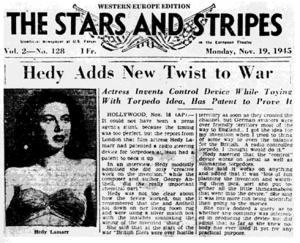On this day in history (yes, this very day) we have a story from guest writer James Hinton, a history buff who knows some cool things about various subjects. He has previously been published on "Hankering for History" as well as his own site. We are happy to publish his submission about a largely unknown aspect of the life of one of most beautiful movie stars in history. Instead of frequently hopping from bed to bed as many sex symbols do, she invented "frequency hopping." Brains and beauty, what a concept.
Grant Davies
By James Hinton
Cheeky Austrian Hedy Lamarr was a hit when MGM imported her iconic good looks and put them up on the silver screen. She starred as a seductive femme fatale alongside of actors like Clark Gable, James Stewart, and Spencer Tracy. Despite being tasked to sell war bonds, she made fourteen movies during WWII alone. What many people don’t realize is that movies aren't the only things Lamarr made during WWII.
Originally married to a fascist munitions manufacturer, the Jewish born, Catholic raised Lamarr had accompanied her husband to many meetings, learning the ins and outs of weapons manufacturing. Infuriated by German submarine attacks on passenger liners, she put her brilliant mind to work coming up with a solution.
Working alongside of composer George Antheil, Lamarr focused on inventing a means by which torpedoes could be controlled by radio. Such control had been attempted before, but always ran afoul of the same problem time and time again. Any signals controlling the torpedo could be jammed by the enemy. Lamarr’s solution was to rapidly cycle through multiple frequencies in a pattern stored aboard both the torpedo and the ship.
“Frequency hopping” was patented in August of 1942, with plenty of time for it to be adopted and put to use hunting German and Japanese ships. Unfortunately, the U.S. Navy, notoriously sensitive about the poor performance of its current torpedoes, refused to adopt the technology until the 1960s.
The technology did not languish, however. Starting with walkie-talkies, frequency hopping began to see use in radios, simultaneously securing communications against eavesdropping and against multiple conversations talking over one another using the same frequency. These techniques would eventually be adapted for computer communication, resulting in the Wi-Fi and Bluetooth technologies that are key to today’s digital revolution.
Hedy Lamarr passed away in 2000 at the age of 85. She was memorialized as a world-famous actress and sex symbol. As important as her contribution was to film, it is today's cell phones and wireless networks, however, that are her strongest legacy.





